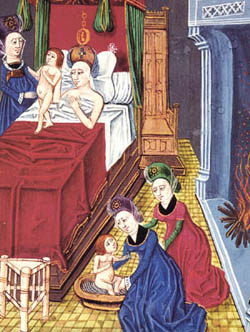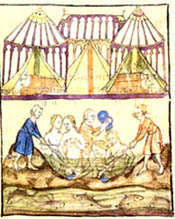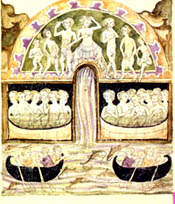Friday, April 10, 2015
Another Moslem-Enlightenment lie; 'Christians never bathed'.....
No end to the ridiculous nonsense about the Middle Ages.
by Ferdinand III
One has to be fearfully uneducated to believe propaganda without casting a rational doubting eye upon the claim and claimant. 'Enlightenment' philosophes pious in their Atheism or Protestant belief systems, looking upon 500 year old Cathedrals and pronouncing them 'Gothic', a pejorative for barbaric – are hardly the bien pensants that one should listen to or believe. Their ignorance is not 'science' or 'fact'. The great structures of worship which beguile and beckon tourists today can hardly be the outputs of a 'dark age', as mythical and as ridiculously inane as that term is. An age which invented everything imaginable from books to eye-glasses, and blast furnaces to massive grinding mills was not dark.
Witness bathing. The big brains say that the Medieval Christian, toothless, wearing sackcloth, with long shaggy hair, never knew a bath, and when they did, they ran from water as a cat runs from a dog. This is an oft-repeated Moslem lie, as if Islam has invented anything other than Jihad, sex slaving and death. Bathing was common in Roman Europe and that tradition was certainly embedded in the superior culture which followed the non-existent 'fall of Rome'. [Rome was dead long before 476 AD.] Bathing was known, common and at times, a community event in Medieval Europe [which brought its own problems of lack of privacy and even prostitution].
Bathing
and bouquets
Marian Horvat, Phd. "The next time you are washing
your hands and complain because the water temperature isn't just how
you like it, think about how things used to be. Here are some facts
about the 1500's:
Most people got married in June, because they
took their yearly bath in May and still smelled pretty good by June.
However, they were starting to smell, so brides carried a bouquet of
flowers to hide the body odor. Hence the custom today of carrying a
bouquet when getting married.
|
|
These are not facts, but
falsehoods.
Many people
married in May or June because they were Catholics and the Church
wisely proscribed marriages from being celebrated during the Lenten
season, a time of abstinence and penance. By the way, this pious law
continued to be followed by good Catholics until Vatican II swept out
so many of the good traditions that developed in the Age of
Faith.
As for the
yearly-bath myth, medievalists have long laid to rest the idea that
people rarely bathed in the Middle Ages. The Middle Ages was a period
of hygiene and cleanliness. The
first bit of evidence we have is the prevalence of soap,
a common product used for washing clothes and washing people. Next,
there are multiple references in literature and manuscripts to
bathing, treated matter-of-factly, as something common place.
Charlemagne, for example, used to bathe each morning in a large pool
or river, where he would meet with his ministers, who were also
invited to bathe.
Bathing was part of a ritual
before certain ceremonies, such as knighthood, and in the romances of
chivalry we see that the laws of hospitality required offering guests
a bath before they dined.
|
Scenes from 14th century thermal baths houses, popular at the time. The establishments were served by river currents |
The first
etiquette manuals (13th century), as well as the various monastic
Rules, specified washing the hands before eating, and keeping the
hair, fingernails and clothing clean. Clearly, washing was frequent –
there is evidence all over the place for people washing their hands,
faces and feet on a daily basis.
Monastic
rules usually had previsions that stipulated washing one’s hair and
bathing once each week, usually on a certain day. We can also see how
the medievals utilized running rivers or streams. The monks of Cluny
were the first to take advantage of the nearby running stream to use
as a type of indoor plumbing system. One can still find there
numerous lavatories close to the refectories.
A
saying in France from those days shows how cleanliness was considered
one of the pleasures of existence:
Venari, ludere, lavari, bibere; Hoc est vivere!
(To hunt, to play, to wash, to drink, - This is to live!)
One
thing I might add, care should be taken not to attribute to the 13th
century the revolting uncleanliness of the 16th and subsequent
centuries which, in France at least, has continued up to our own
time.
As
for the bridal bouquet, it was one of numerous beautiful symbolic
customs that developed around the Sacrament of Matrimony that we have
inherited. For the medieval mind, which saw in all nature a
reflection of the Creator, each flower had a symbolic value and
displayed a message.
Orange
blossom, popular for bridal bouquets, denoted chastity, purity and
loveliness. A sprig of ivy was included in bouquets as a symbol of
fidelity. Roses represented love, and the lily of the valley,
happiness, and so on. The flowers of the bridal bouquet had real
meaning; they were not meant to disguise foul odors from a supposedly
unwashed bride and groom."


